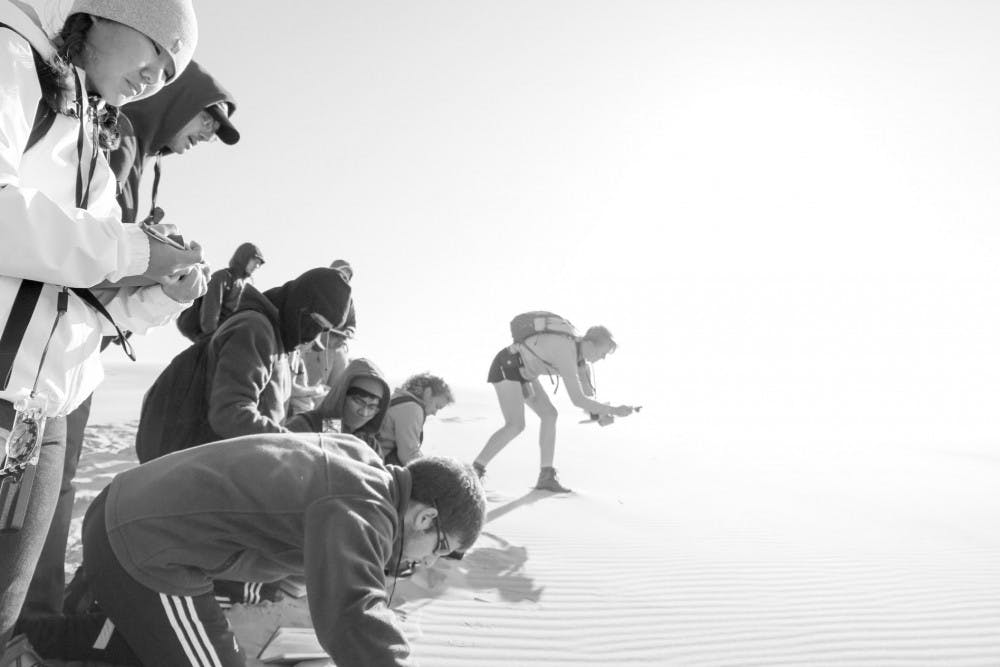Imagine walking along the beach of Cyprus and appreciating the Earth’s mantle flattened out before you, doing yoga in the morning and star-gazing at night, making a groundbreaking discovery about the geology and archaeology of an extraordinary landscape. All this and more has been done in the freshman seminar FRS 124: State of the Earth: Shifts and Cycles, a geology and STL requirement-fulfilling class that engages a small group of students in learning about the Earth’s past.
This year, the course will be travelling to Spain and France to study geological sites. Professor Adam Maloof and Professor Frederik Simons from the Geosciences Department have been teaching this course together for the past few years. According to Maloof and Simons, the locations for these trips change every three years to make sure that everyone in the course — including the professors — arrive at the sites with fresh minds and fresh materials to study. Previous trips have taken students to California and Cyprus.
When asked about the criteria for choosing their locations, both professors unhesitatingly said that they let geology and student experience decide. According to Maloof, the site has to be “beautiful enough and also accessible enough,” so that a freshman student with absolutely no background in geology can always find something of interest to study. The trips to France and Spain will focus on time series analysis, and the professors are currently working to decide on their next location.
In preparation for the trips, students spend time in labs learning skills of data collection, quantitative modeling, and equipment operation. They also design independent projects, which they carry out in groups of two or three when in the field, where they are able to conduct research in the natural world.
 A typical day on the site begins with breathtaking views and ends with data summary. In the middle, the students get into their small groups to work on their independent projects. The students collaborate a lot as well; they share data with one another, and interchange roles as leaders of their own group and assistants of another. Ray Bartolucci ’17, a CBE maj
A typical day on the site begins with breathtaking views and ends with data summary. In the middle, the students get into their small groups to work on their independent projects. The students collaborate a lot as well; they share data with one another, and interchange roles as leaders of their own group and assistants of another. Ray Bartolucci ’17, a CBE maj or and previous student of the course, said that “the teamwork was amazing.”
or and previous student of the course, said that “the teamwork was amazing.”
The professors also work closely with the students and provide invaluable guidance on the site. Marcus Spiegel ’17, a CEE major who also took the course, said that the professors “work together so well that they are almost like yin and yang.” He added that the course was a one-of-a-kind opportunity to “spend a lot of time with professors and really get to know them.”
The professors describe the students in the course as a “melting pot.” Students come in with diverse academic interests but with the same curiosity for scientific exploration. They come back with more grounded knowledge in data analysis, experience in working with the most shocking natural wonders, and friendships with professors and classmates that sometimes span the next three years of their Princeton careers.
Vidushi Sharma ’17, a previous member of the class, said that she “has taken plenty of walks and met with both professors to talk about [her] independent paper on philosophy.” She eventually became a philosophy major, but the multidisciplinary nature of the course helped her to connect classics and geoscience in her research.

At the end of the interview, Simons asked the reporter what major she was thinking about. When the reporter responded with economics, he commented that the course could be understood in economics terms. "The students experience enough highs but also enough lows in this course. But the highs always offset the lows," he said.
“The course is hard, but rewarding," Simons noted.









